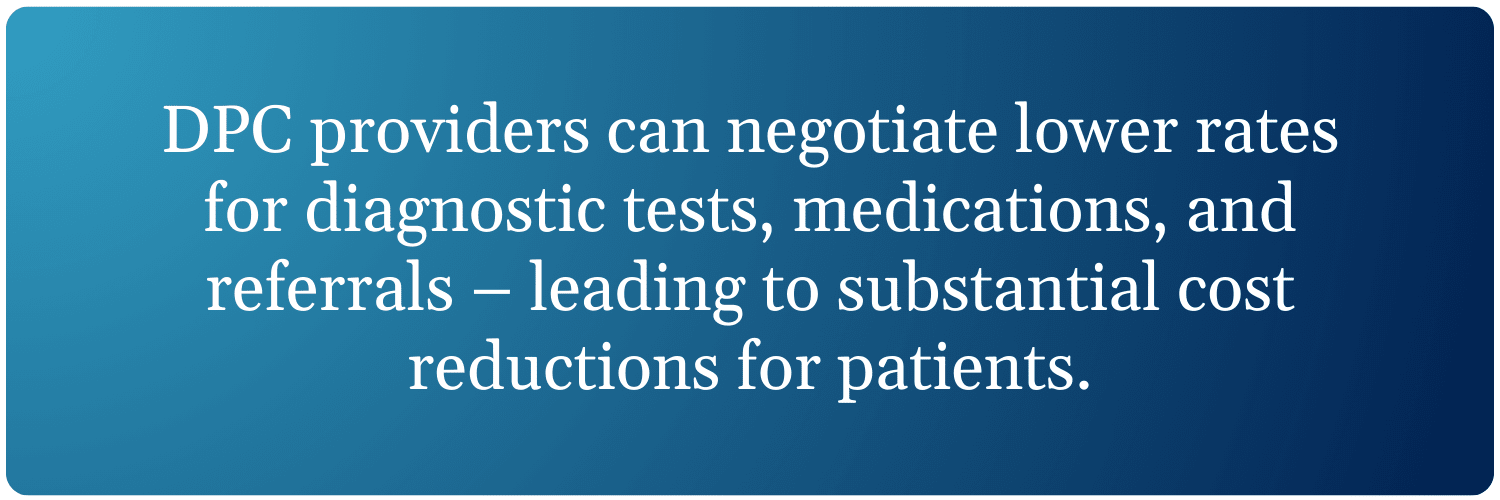

This blog was originally published in June 2017 and was updated in June 2023.
Direct primary care (DPC) is swiftly growing in popularity in the healthcare industry. But what is direct primary care, and how does direct primary care work?
We will discuss what direct primary care is, what it means to be a DPC physician, and the benefits of the direct primary care model for doctors and patients – so you can decide if this model is right for your practice.
Direct primary care is an innovative model of primary care that gives physicians alternatives to traditional fee-for-service insurance billing. Reducing the overhead for third-party insurance allows physicians to lower fees and spend quality time with fewer patients – for the same cost.

What is direct primary care at its essence? It is a patient-centric model that allows you to spend more time with your patients and prioritize the patient-physician bond.
The unique payment structure of direct care eliminates many of the administrative burdens physicians face – so what is a DPC physician’s time spent doing?
The DPC model frees up more time for physicians to focus on patient care and engagement. Patient engagement can include:
So now that you have a better understanding of what direct primary care is, how does direct primary care work? Let’s dive into the details.
Direct primary care physicians charge their patients a retainer. This DPC membership may be charged monthly, quarterly, or annually and is used to cover services. These membership fees can easily be managed through a DPC All-In-One membership management system.
Often, supplemental insurance for emergency situations is suggested on top of the DPC membership.
The direct primary care model eliminates insurance-related expenses and reduces reliance on costly medical procedures. Because of this, DPC providers can negotiate lower rates for diagnostic tests, medications, and referrals – leading to substantial cost reductions for patients.
Traditional healthcare has been the standard in the USA for years. In the traditional model, a patient’s health insurance pays for the majority of medical services and products.
Direct primary care, on the other hand, does not rely on payments through health insurance companies.
What is a DPC physician paid with, then?
DPC physicians are paid through direct monthly or annual membership payments from their patients. This model reduces overhead costs and allows for patient care to be more comprehensive and personalized.
The direct primary care model has many benefits for both physicians and patients.
Physicians experiencing burnout might find that direct primary care is what works best for them. Benefits of direct primary care for physicians include:
Having a DPC membership has many benefits for patients as well, including:

Whether you are a DPC veteran, a new DPC physician, or considering starting a DPC practice, doing your research and staying up-to-date on the latest in direct primary care models can help you achieve your practice goals.
Elation EHR is a leading electronic health record (EHR) system specifically designed for DPC providers. This direct care EHR allows for simplified documentation, streamlined communication, and enhanced patient data management.
Request a demo of Elation Health EHR, and download our helpful DPC Checklist to get expert insights into everything you need to know to run a successful DPC practice.
Making the decision to establish a new primary care practice is an exciting first step in your direct care journey. Download our free Direct Primary Care checklist to get an expert step-by-step guide to starting your own DPC practice.
Here are commonly asked questions about what direct primary care is and how it helps patients:
“Direct patient care” is often used interchangeably with “direct primary care.” Direct primary care is the official term, and it is a system that eliminates third-party insurance costs so doctors can focus more time and energy on patient relationships and outcomes.
A DPC physician is a physician who follows a direct primary care model of service.
There are so many benefits of direct care! Direct primary care allows physicians to lower costs, spend more one-on-one time with each patient, and provide better outcomes for patient care.
The primary care model supports comprehensive and accessible care for a patient’s health needs. A primary care physician is the first point of contact for patients in the healthcare system.


23 days ago
For the second year in a row, and the second time in my life, I recently attended the American Academy of Family Physicians National Conference. Read more here.
Read Article
23 days ago
The AAFP National Conference 2024 was in full swing, and I found myself swept up in a sea of eager faces—the next generation of family physicians ready to shape the future of healthcare.
Read Article
about 2 months ago

about 2 months ago
MedCity News recently published an article featuring Elation's latest survey results on the impact of AI and shared insights from Elation's VP of Engineering and AI Innovation Lead.
Read Article
about 2 months ago
In this piece for Fast Company, Elation's co-founder and CEO, Kyna Fong explores how AI should and can be designed for trust in the healthcare setting.
Read Article
2 months ago
Value-based care and its underlying value-based payment schemes are a complete paradigm shift that many believe will improve how the U.S. delivers and pays for care. How did value-based payment emerge
Read Article Driving Preferred Behavior: Changing Incentives & Care Delivery Under Value-Based Care" />
Driving Preferred Behavior: Changing Incentives & Care Delivery Under Value-Based Care" />
3 months ago
We’ve established that the U.S. has the most expensive and worst performing healthcare system in the developed world. It’s admittedly a grim situation, but we also know that there are many people who
Read Article
6 months ago
In this post we'll try understand how value-based care emerged as the hopeful solution and how its reimbursement goals and care delivery differ significantly from those of FFS.
Read Article
6 months ago
This post is part of a series of blog posts aimed at unpacking the value based payment for primary care practices looking to make the transition to value based care.
Read Article
6 months ago
This post is part of a series of blog posts aimed at unpacking the value based payment for primary care practices looking to make the transition to value based care.
Read Article
about 2 months ago
Learn why Dr. Sara Pastoor and Dr. Andrew Carroll see a future for independent primary care emerging in collaborative care models.
Read Article
2 months ago
The following article is a version of a piece that was published on KevinMD. In it, Elation's CEO and co-founder, Kyna Fong, comments on the importance of developing AI that supports quality care.
Read Article
2 months ago
Below is a version of an article that was originally published in Fierce Healthcare. In this article, Elation CEO and co-founder, Kyna Fong, discusses the emergence of primary care-led systems of care
Read Article
2 months ago
Elation recently conducted a survey to learn from 156 primary care clinicians who are current Elation customers on the specific challenges hindering their craft of medicine.
Read Article
Elation recently conducted a survey to learn from 156 primary care clinicians who are current Elation customers on the specific challenges hindering their craft of medicine.
Read Article
3 months ago
Elation recently launched Collaborative Billing – an integrated billing solution. This integration allows clinicians to use incident-to billing.
Read Article the Right Value-Based Contracting Model as a Physician" />
the Right Value-Based Contracting Model as a Physician" />
3 months ago
By reading this article, you'll gain valuable insights into the different types of value-based contracting models, their pros and cons, and key factors to consider when selecting a model.
Read Article
3 months ago
The future of value-based care (VBC) is poised for significant transformation, driven by several key trends that are reshaping the healthcare landscape.
Read Article
3 months ago
This article will delve into the importance of value-based care analytics, the critical metrics to monitor, and how these metrics can lead to improved patient outcomes and overall efficiency.